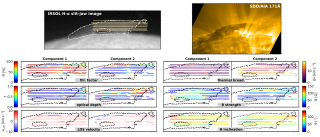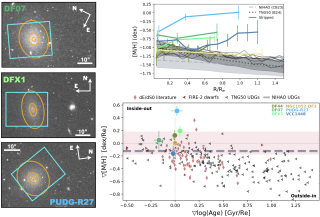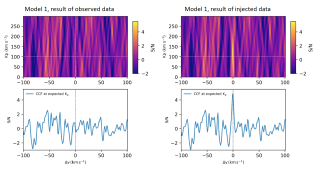We find a distinct stellar population in the counterrotating and kinematically decoupled core of the isolated massive elliptical galaxy NGC 1700. Coinciding with the edge of this core, we find a significant change in the slope of the gradient of various representative absorption line indices. Our age estimate for this core is markedly younger than the main body of the galaxy. We find lower values for the age, metallicity, and Mg/Fe abundance ratio in the center of this galaxy when we compare them with other isolated elliptical galaxies with similar velocity dispersion. We discuss the different possible scenarios that might have lead to the formation of this younger kinematically decoupled structure and conclude that, in light of our findings, the ingestion of a small stellar companion on a retrograde orbit is the most favored.
Advertised on
References
2011, ApJ, 732L, 33K
It may interest you
-
 Understanding the magnetic field in the corona is key for explaining the fascinating physical processes occurring there. However, the extreme conditions in the outer solar atmosphere hamper the possibility of acquiring observations with enough quality to infer the coronal magnetic field. Analyzing observations of overdensities of cold plasma supported by coronal magnetic fields, including filaments and prominences, allows us to understand such magnetic fields and their interaction with plasma. In this study, we have analyzed an active region prominence, a type of prominence that has barelyAdvertised on
Understanding the magnetic field in the corona is key for explaining the fascinating physical processes occurring there. However, the extreme conditions in the outer solar atmosphere hamper the possibility of acquiring observations with enough quality to infer the coronal magnetic field. Analyzing observations of overdensities of cold plasma supported by coronal magnetic fields, including filaments and prominences, allows us to understand such magnetic fields and their interaction with plasma. In this study, we have analyzed an active region prominence, a type of prominence that has barelyAdvertised on -
 Ultra-diffuse galaxies, an extreme type of dwarf galaxy, have been the focus of extensive observational and theoretical studies over the past decade. With stellar masses comparable to dwarf galaxies (between 10 7 and 10 9 solar masses) but much larger in size (as defined by their effective radius), they exhibit an extremely low surface brightness. These galaxies display highly diverse properties: some have large dark matter halos, others lack them, and their number of globular clusters varies widely. Studies of their kinematics and stellar populations have shown that these extreme galaxiesAdvertised on
Ultra-diffuse galaxies, an extreme type of dwarf galaxy, have been the focus of extensive observational and theoretical studies over the past decade. With stellar masses comparable to dwarf galaxies (between 10 7 and 10 9 solar masses) but much larger in size (as defined by their effective radius), they exhibit an extremely low surface brightness. These galaxies display highly diverse properties: some have large dark matter halos, others lack them, and their number of globular clusters varies widely. Studies of their kinematics and stellar populations have shown that these extreme galaxiesAdvertised on -
 The rocky planet GJ 1132 b, with Earth-like mass and radius, is a prime candidate for atmospheric studies. Previous observations with Hubble and JWST yielded conflicting results about its atmosphere. This study used three transit observations with the CRIRES+ instrument to search for He i, HCN, CH₄, and H₂O in GJ 1132 b's atmosphere. No clear atmospheric signals were detected, but upper limits for CH₄, HCN, and H₂O were established. The results suggest that if GJ 1132 b has an atmosphere, it is not dominated by hydrogen. The work highlights the challenges of detecting high molecular weightAdvertised on
The rocky planet GJ 1132 b, with Earth-like mass and radius, is a prime candidate for atmospheric studies. Previous observations with Hubble and JWST yielded conflicting results about its atmosphere. This study used three transit observations with the CRIRES+ instrument to search for He i, HCN, CH₄, and H₂O in GJ 1132 b's atmosphere. No clear atmospheric signals were detected, but upper limits for CH₄, HCN, and H₂O were established. The results suggest that if GJ 1132 b has an atmosphere, it is not dominated by hydrogen. The work highlights the challenges of detecting high molecular weightAdvertised on